The crypto exchange OKX is removing the trading pairs in USDT (Tether’s stablecoin) for European users.
Breaking: @Tether_to $USDT pairs have been removed by @okx in the EU 👀
— MartyParty (@martypartymusic) March 18, 2024
Only $EUR and $USDC @circle pairs now allowed. Huge news. pic.twitter.com/E1HNHRaLkB
The problem seems to be only of a legal nature, and linked to the new MiCA regulation that is coming into force this year.
Summary
The problem of Tether’s stablecoin within the OKX exchange
The MiCA is a regulation of the European Union that has legal value only in EU countries.
This regulation introduces the concept of e-money token, or stablecoin tokens redeemable at par with the underlying asset.
USDT, which is Tether’s stablecoin collateralized in USD, is effectively redeemable on a one-to-one basis with the underlying asset, but it does not seem to have all the characteristics to fully fit into the category of e-money tokens under MiCA.
USDT holders can redeem their tokens in exchange for an equal amount of USD by returning them directly to Tether, but only for amounts over $100,000 and with a 1% fee.
For lower amounts and lower fees, you can do this on the Bitfinex exchange, which belongs to the same group as Tether (iFinex), simply by depositing USDT and selling them in exchange for USD.
In this case, however, it is not certain that the amount in USD received by selling them is exactly equal to the number of USDT sold, even if the exchange rate almost always hovers around $1.
If the e-money tokens defined by MiCA were simply tokens redeemable at par in fiat currency, Tether’s stablecoin would fully fall within this definition, but it is not so.
The e-money tokens
The European MiCA distinguishes e-money tokens (EMTs) both from real cryptocurrencies and from tokens collateralized in other assets, such as gold.
The EMTs are in all respects hybrid assets, on one hand crypto-assets and on the other electronic money in every respect.
This last feature makes them subject to the existing regulations on electronic currencies and payment services, and this is where the problems arise for Tether.
These hybrid crypto-assets are therefore expressly classified as electronic money pursuant to art. 2, par. 2, of the EC directive 110 of 2009. In 2009, not only stablecoins did not exist yet, but altcoins did not exist either, since the same Bitcoin had just been born.
This regulation effectively decrees that EMTs must be issued by authorized entities such as credit institutions or electronic money institutions, and apparently Tether (the issuer of USDT) does not have these characteristics according to European regulations.
Furthermore, it also decrees that they must attribute to the holder a right to reimbursement from the issuer, at any time and at face value.
Therefore, it does not actually seem that USDT can fully fit into the definition of MiCA e-money token, although it also does not seem possible to exclude that it may eventually fit into it.
The delisting of the USDT (Tether) stablecoin from the OKX exchange
OKX is one of the top ten crypto exchanges in the world for trading volumes, even though its activity is mainly concentrated in Asia.
However, it also serves several European clients, and has decided to tackle the problem head-on to avoid legal issues with EU countries.
So it is simply closing access to USDT exchange pairs for all residents in EU countries.
Note that the same does not apply to the other major stablecoin, USDC, which is still available.
It should be noted, however, that the first three pairs for volume trading on OKX are in USDT, as are the first eight out of ten pairs.
Facing a daily trading volume of about 7.1 billion dollars, a total of 3.2 billion is generated by the top three pairs, all in USDT: BTC/USDT, ETH/USDT, and SOL/USDT.
So the delisting of pairs in USDT for European users is a real problem.
It is not yet clear whether this should be considered a definitive delisting or just temporary, and if other exchanges could opt for similar solutions.
It should be added that it would be rather strange if Tether did not decide to take action and comply with the new MiCA regulations.
The problem in the EU
The key point of this whole issue is actually the de facto obligation for e-money token issuers to be recognized by authorities as authorized electronic money institutions.
Circle, which is behind USDC, is, therefore, it doesn’t seem absurd to imagine that it could also become Tether.
In fact, not only USDC on OKX has remained available for European users, but it does not seem that there are conditions for it to be removed from other exchanges, as it seems to be the case for USDT in the EU if things do not change.
After all, the goal of the EU is to align regulatory standards for stablecoin issuers with those of fiat electronic money, and it is no coincidence that Circle has already complied.
Circle is an American company, while Tether is not, and has already been recognized by US authorities as an authorized electronic money institution in order to be able to operate in compliance with the law in the USA.
It is therefore possible that this is the direction in all major jurisdictions around the world, not just in the EU. This makes it even more likely that Tether will eventually follow in Circle’s footsteps and become authorized as an electronic money institution in the EU.
 en.cryptonomist.ch
en.cryptonomist.ch
